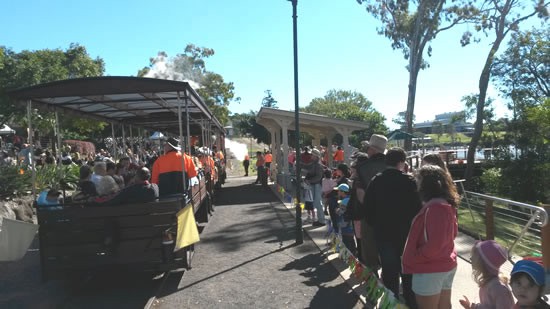Mary Ann Steam Train
The original Mary Ann was the first steam train locomotive built in Queensland by John Walker & Co. Ltd. in 1873. The loco was built for timber pioneers William Pettigrew and William Sim who used the Mary Ann to haul logs in the Tin Can Bay area.
The replica Mary Ann was built in Maryborough by Wm Olds & Sons Pty. Ltd. Many businesses and individuals have contributed to make the Mary Ann dream become a reality.
On each Thursday (market day in Maryborough) and the last Sunday of each month between 9am and 12pm, and on special occasions, the Mary Ann operates from Macalister Station, behind the Bond Store, in the Wharf Street Precinct.
Macalister Station is the pick-up point for passengers on the Mary Ann to travel over part of the 'Golden Mile', along lower Kent Street to the Hyne timber yards at Tiger Street. In the opposite direction, the track passes close to the Mary River before entering picturesque Queens Park and on to Sussex Street.
Mary Ann Hiring
The Mary Ann steam train is available for private hire for functions such as weddings, family reunions and corporate promotions. Sufficient notice is requried so that the necessary permits/track authority can be obtained. View our Hiring poster here!
Contact us for details of costs and arrangements.
Facts about the Mary Ann
• The name 'Mary Ann' came from the names of William Pettigrew's and William Sim's daughters. Both Scottish timber pioneers had daughters named Mary Ann.
• William Pettigrew began surveying a railway line in 1872, finding a suitable terminus near Cooloola Creek.
• The original locomotive actually ran on 3' 3" gauge railway line, instead of Queensland Rail's narrow gauge 3' 6". It is thought by many historians that a mistake was made in the selection of the gauge.
• The rails were cut from spotted gum and measured 5" x 4" through their cross-section. The sleepers were made from cypress pine (7" x 4½") and were notched to receive the rails which were fastened into the sleepers with wedges.
• Mary Ann's boiler stood upright instead of horizontal. With this arrangement, the wheels could be placed close together so the locomotive could work around the sharper curves.
• The 8 horsepower engine, which powers the Mary Ann, could haul 40 tons of logs and was designed to run at about 8 miles per hour.
• When the Mary Ann was not busy hauling logs, her engine was used to power a circular saw. The saw, which was mounted on a flat wagon, was used to cut sleepers and rails needed to take her even further into the wilderness. The engine would be put out of gear and a flat leather belt connected between Mary Ann's flywheel and the circular saw spindle.
• The off-cuts from the timber cut on the saw bench provided the fuel for the Mary Ann.
• The original Mary Ann was built by John Walker & Co, now Downer Rail. This company has built more locomotives than any other company in Australia.
• Mary Ann was taken to Cooloola from John Walker & Co., down the Mary River, through the Great Sandy Strait and into Tin Can Bay on a punt towed by the steamer 'Hercules'.
• In a few hours, the Mary Ann could haul a load of timber to the rafting grounds at Cooloola Creek. This is a feat which would have taken a bullock team two to three weeks to achieve!
• The kauri pine logs were chained together to form rafts which were floated with the tide and the help of a paddle-wheeler tug 'Hercules' to the Dundathu sawmill downstream from Maryborough on the Mary River.
Weight: Original 6 tons, Replica 9 tonnes.
Costs: Locomotive original £600 (1873), Replica $250,000 (1998)
First Carriage: $25,000 (1999), Constructed of Queensland blue gum timber.
Second Carriage: $31,300 (2002), Constructed of kauri pine timber.
Third Carriage: $32,000 (2008), Constructed of silky oak timber.
Engine: 2 Cylinders, 6" bore x 10" stroke, both high pressure with side valves and Stephenson's link motion valve gear. Normal operating speed: 150RPM @ 8 horsepower.
Boiler: Vertical fire tubes: 135 x 1 & 5/16" (33.5mm) steel tubes.
Operating Pressure: 120PSI (830 kPa)
Saturated Temperature: 170° C
Fuel: Wood. (approx. 2 wheelbarrow loads per 4 hours)
Wheels and Gauge: Driving Wheel Diameter" 2' 8" (812mm)
Gauge: 3' 6" (1067mm) QR narrow gauge. Original Mary Ann: 3' 3" (991mm)







